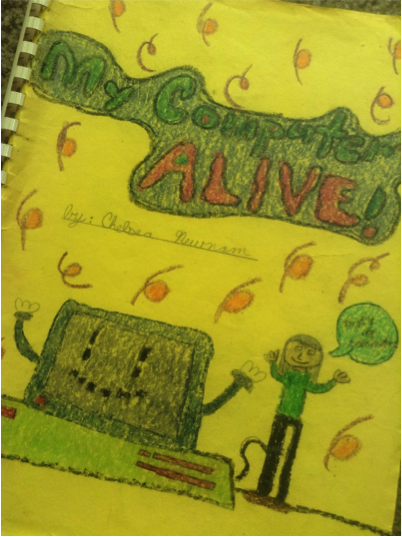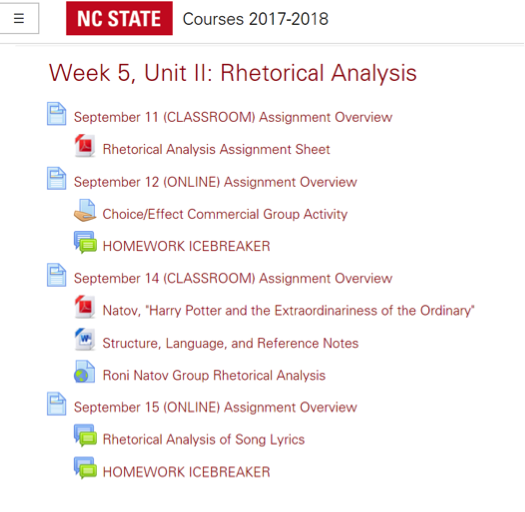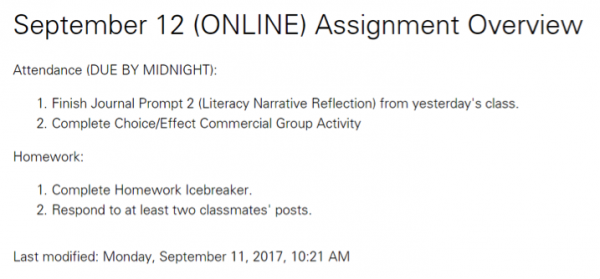Chelsea Krieg is a lecturer in the First-Year Writing Program and holds an MFA in poetry from North Carolina State University. She teaches face-to-face and hybrid classes.
My GPS hasn’t been updated in 10 years. I can barely work a microwave. I don’t even own a smartphone. How am I supposed to run a class online? This is the question I  asked myself (and my husband and my friends and my colleagues) when I was presented the opportunity to teach hybrid sections of ENG101 last fall. I’ve had such a longstanding relationship with this technophobia, that one of the first traceable moments of this fear is evident in a book I wrote in fourth grade, in which a computer literally comes to life and attacks me, the protagonist.
asked myself (and my husband and my friends and my colleagues) when I was presented the opportunity to teach hybrid sections of ENG101 last fall. I’ve had such a longstanding relationship with this technophobia, that one of the first traceable moments of this fear is evident in a book I wrote in fourth grade, in which a computer literally comes to life and attacks me, the protagonist.

My general fear of technology felt like a good enough excuse to turn the offer to teach hybrid down, but with many programs moving to hybrid teaching models at both the high school and college levels, I knew pushing myself out of my comfort zone would be a good idea. And while the idea of teaching a class online felt a bit like preparing to hike Mount Everest in a bikini, I learned to navigate and even enjoy the then-elusive world of online teaching. I also soon came to realize that, thankfully, mad technology skillz are not a prerequisite for designing a successful hybrid classroom community.
Alleviating Concerns
After I got over initial doubts, I realized I had no idea what a hybrid classroom even looked like. I had made many assumptions about its online components, but I’d never seen them in action. I had questions. What are the expectations for hybrid days? How is attendance managed? To find answers, I turned to colleagues, professional development workshops about online teaching, and DELTA workshops.
Veteran online and hybrid teaching colleagues sat down with me and helped me answer these questions, and I quickly learned that my grand notions about sending a hologram teaching persona directly to my students’ laptops as we simultaneously synced our Apple watches at the same time every Monday and Thursday were a tad off.
What I learned, instead, was that hybrid classrooms offer more opportunities for students to delve into and practice writing. They offer a balance of independent reading and writing time with classroom time, and I learned that this is what I needed to know how to offer to be a successful hybrid instructor. When put that way, it seemed so simple. I had been doing this already in my classroom. To be a successful hybrid instructor, I needed to play to my strengths as a trained writing instructor, not magically engineer a tech-savvy Krieg 2.0. My confidence levels rose.
Learning Curve
With that in mind, I reexamined my face-to-face syllabus and began adopting strategies (not unlike those mentioned in Jake Clayton’s advice about getting started with hybrid teaching or Laura Waldrep’s suggestions for using icebreakers to create community) to build my online platform and conceptualize my classroom as a partially virtual space.
Despite my newfound confidence, this change came with a learning curve. Before teaching hybrid sections of ENG101, for example, I was a Moodle minimalist. My Moodle pages were designed to contain a PDF of my syllabus, course readings and assignment sheets, and places to turn in major assignments. I took attendance on paper, took notes on class participation by hand, kept grades in a spreadsheet, and generally avoided the platform. So, when faced with the idea that Moodle would be a necessary tool, I knew my Moodle pages would need facelifts.
I have since found, however, that being forced  to educate myself in Moodle has made my life much more organized, and it has benefited my teaching as a result. Now, my students not only receive a PDF syllabus and daily schedule, but a Moodle space with assignment overviews for each classroom and online day, equipped with necessary links and readings. Moodle gave me a space to organize all the materials for each individual class period. Clicking on any given date will provide the student with all expected readings and assignments to complete for that day.
to educate myself in Moodle has made my life much more organized, and it has benefited my teaching as a result. Now, my students not only receive a PDF syllabus and daily schedule, but a Moodle space with assignment overviews for each classroom and online day, equipped with necessary links and readings. Moodle gave me a space to organize all the materials for each individual class period. Clicking on any given date will provide the student with all expected readings and assignments to complete for that day.
Online attendance assignments for hybrid days allow students to work in groups or individually, and they emphasize the importance of independently exploring concepts discussed in class. I was able to design assignments that more efficiently and actively engaged the student with concepts presented during lectures, and Moodle offered me a platform to present, collect, and assess those activities.
And, it was a lot easier than I originally anticipated. With resources like An Instructor’s Guide to Using Moodle, Moodle was easy to navigate. I was able to create assignments and implement my ideas with little trouble. Since making this switch, I now teach both hybrid and face-to-face sections with heavy reliance on Moodle spaces. This newfound relationship felt all the more rewarding when the class’s use of Moodle was praised in student evaluations last fall—a feat I never would have accomplished without the impetus of hybrid teaching.
A Not-So-Dumb Dummy
As a new hybrid instructor, I’m still learning the ins and outs of teaching a class partially online and partially in the classroom. I have learned, however, to look for opportunities to play to my strengths as an instructor in the virtual space, and I’ve learned a lot along the way. Teaching hybrid has not only made me more versatile; it has impacted my classroom teaching in positive ways. So, if you are interested in teaching a hybrid course, don’t let the fear of technology stop you. Though the platform is not without challenges, these challenges ask instructors to find innovative ways to emphasize and adapt pre-existing strengths to the digital classroom. And, while I still don’t know what to do when the equipment in T129 is on the fritz, I’m a little less afraid of the online classroom (and lurking computer-monsters).
